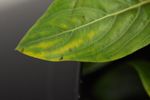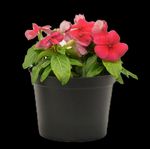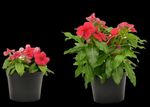Begonia and Vinca Sensitivity to Paclobutrazol Drenches - e-GRO
←
→
Page content transcription
If your browser does not render page correctly, please read the page content below
W. Garrett Owen
wgowen@uky.edu
Volume 10 Number 20 April 2021
Begonia and Vinca Sensitivity 2021 Sponsors
to Paclobutrazol Drenches
Plant growth regulators (PGRs) can be successfully used to
control growth or induce lateral branching of many bedding
plant species, but some may be ‘sensitive’ to the PGR active
ingredient. This Alert demonstrates PGR sensitivity for fibrous
begonia and vinca where an accidental paclobutrazol drench
application resulted in stunted plants, chlorotic (yellowing)
leaves, and black spotting.
To produce high-quality compact flowering plants proportional to
container size, growers can use non-chemical and chemical
methods. While non-chemical methods can be successfully
deployed, most greenhouse growers use chemical plant growth
regulators (PGRs). These chemicals can be applied by various
methods to either suppress or promote growth, increase
branching, and/or promote or delay flowering of greenhouse
crops. Most PGRs can be applied to floriculture crops, but there
are instances where the labels warn against application on
certain bedding plants species because of their sensitivity to the
active ingredient. A perfect example of PGR sensitivity was
observed during a recent greenhouse visit.
Reprint with permission from the
Small plantings each of fibrous begonia (Begonia × semperflorens- author(s) of this e-GRO Alert.
cultorum) and vinca (Catharanthus roseus) grown under the same greenhouse conditions
were inspected because each species exhibited abnormal growth. For fibrous begonias,
few plants exhibited hardened, stunted plant growth with dark green leaves (Fig. 1). Only
a few plants in the same row exhibited the symptoms. Asymptomatic begonia plants
exhibited ‘normal’ growth (Fig. 2). Similarly, a few containers of vinca exhibited stunted
plant growth compared to other plants found among the crop (Fig. 3). Stunted plants
displayed chlorosis to interveinal chlorosis (yellowing; Fig. 4) and black leaf spotting (Fig.
5). After speaking with the grower, it was revealed that both bedding plants species were
www.e-gro.org
1Begonia and Vinca Sensitivity to
e-GRO Alert - 2021 Paclobutrazol Drenches
accidentally drenched with 3 ppm (0.0125
mg active ingredient per pot)
paclobutrazol (0.4% active ingredient).
Since only a few plants were accidentally
drenched the crop was not a complete
failure but could have been a lot worse
regardless of crop size and production
scale.
Therefore, before applying any PGRs,
growers should always read and follow the Figure 1. Fibrous begonias (Begonia × semperflorens-cultorum)
label, be familiar with MSDS sheet(s) for exhibiting hardened, stunted growth with dark green leaves as a
response from an accidental drench application of 3 ppm
health hazards, know the personal (0.0125% mg active ingredient per pot) of paclobutrazol.
Photo by: W. Garrett Owen.
protective equipment (PPE) requirements,
and be aware of bedding plant species- or
cultivar-specific notes. In some instances,
labels will acknowledge or warn against
the use of the PGRs on sensitive bedding
plant species because of the potential for
© W. Garrett Owen
phytotoxicity. Growers should conduct an
in-house trial for first time chemical use
or if a species is not listed. Additionally,
growers can contact the PGR technical
manager or your greenhouse Extension
specialist to obtain more information or
Figure 2. Comparison of symptomatic (left) and asymptomatic
address questions. (right) fibrous begonias (Begonia × semperflorens-cultorum)
that either received an accidental drench application of 3 ppm
(0.0125 mg active ingredient per pot) of paclobutrazol or no
Finally, there are many educational drench. Photo by: W. Garrett Owen.
resources and authored by e-GRO
members. Three excellent resources
include:
• 2021-22 Plant Growth Regulators for © W. Garrett Owen
Annuals guide by Dr. Brian Whipker,
NC State.
• 2020-21 Growth Regulators for
Containerized Herbaceous Perennial
Plants guide by Dr. Joyce Latimer,
VirginiaTech.
Figure 3. Vinca (Catharanthus roseus) exhibiting stunted plant
growth (left) compared to a ‘normal’ plant (right) taken from
the crop that was not accidentally drenched with 3 ppm (0.0125
• PGRMix Master can assist you in mg active ingredient per pot) paclobutrazol.
mastering all your PGR needs. Photo by: W. Garrett Owen.
www.e-gro.org 2Begonia and Vinca Sensitivity to
e-GRO Alert - 2021 Paclobutrazol Drenches
Figure 4. Stunted vinca (Catharanthus roseus) plants exhibiting chlorosis to interveinal chlorosis (yellowing). Photos were taken of plants
that were accidentally drenched with 3 ppm (0.0125 mg active ingredient per pot) paclobutrazol. Photo by: W. Garrett Owen.
© W. Garrett Owen
© W. Garrett Owen
© W. Garrett Owen
Figure 5. Variation of black leaf spotting symptomology of vinca (Catharanthus roseus) plants that were accidentally drenched with 3
ppm (0.0125 mg active ingredient per pot) paclobutrazol. Photos by: W. Garrett Owen.
www.e-gro.org 3e-GRO Alert - 2021
e-GRO Alert Cooperating Universities
www.e-gro.org
CONTRIBUTORS
Dr. Nora Catlin
Floriculture Specialist
Cornell Cooperative Extension
Suffolk County
nora.catlin@cornell.edu
Dr. Chris Currey
Assistant Professor of Floriculture
Iowa State University
ccurrey@iastate.edu
Dr. Ryan Dickson
Greenhouse Horticulture and
Controlled-Environment Agriculture
University of Arkansas
ryand@uark.edu
Thomas Ford
Commercial Horticulture Educator
Penn State Extension
tgf2@psu.edu
Dan Gilrein
Entomology Specialist
Cornell Cooperative Extension
Suffolk County
dog1@cornell.edu
Dr. Joyce Latimer
Floriculture Extension & Research
Virginia Tech
jlatime@vt.edu
Heidi Lindberg
Floriculture Extension Educator
Michigan State University
wolleage@anr.msu.edu
Dr. Roberto Lopez
Floriculture Extension & Research
Michigan State University
rglopez@msu.edu
Dr. Neil Mattson
Greenhouse Research & Extension
Cornell University
neil.mattson@cornell.edu
Dr. W. Garrett Owen
Greenhouse Extension & Research
University of Kentucky
wgowen@uky.edu
Dr. Rosa E. Raudales
Greenhouse Extension Specialist
University of Connecticut
rosa.raudales@uconn.edu
In cooperation with our local and state greenhouse organizations
Dr. Beth Scheckelhoff
Extension Educator – GreenhouseSystems
The Ohio State University
scheckelhoff.11@osu.edu
Dr. Ariana Torres-Bravo
Horticulture/ Ag. Economics
Purdue University
torres2@purdue.edu
Dr. Brian Whipker
Floriculture Extension & Research
NC State University
bwhipker@ncsu.edu
Dr. Jean Williams-Woodward
Ornamental Extension Plant Pathologist
University of Georgia
jwoodwar@uga.edu
Copyright © 2021
Where trade names, proprietary products, or specific
equipment are listed, no discrimination is intended and
no endorsement, guarantee or warranty is implied by
the authors, universities or associations.
www.e-gro.org 4You can also read



























































